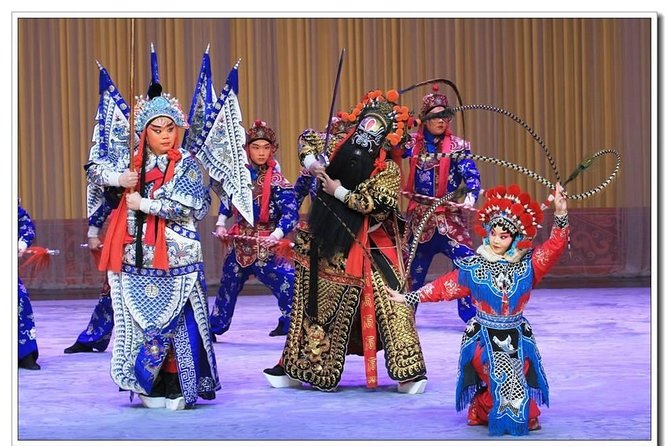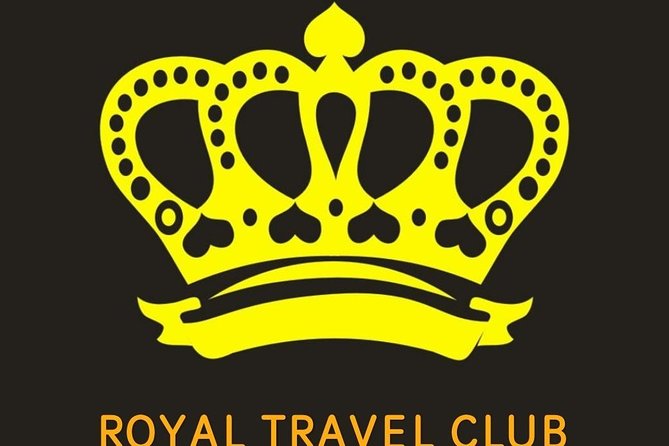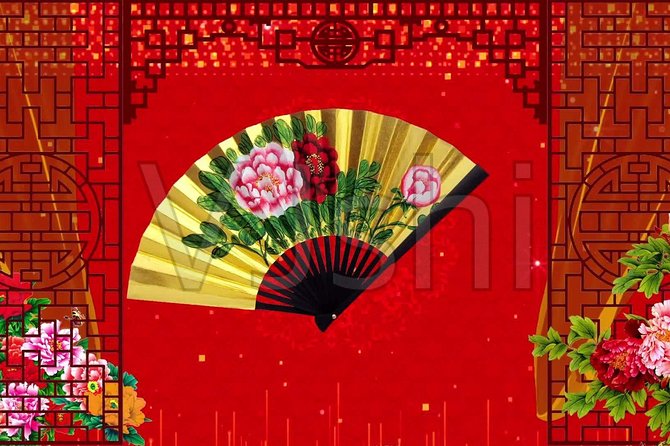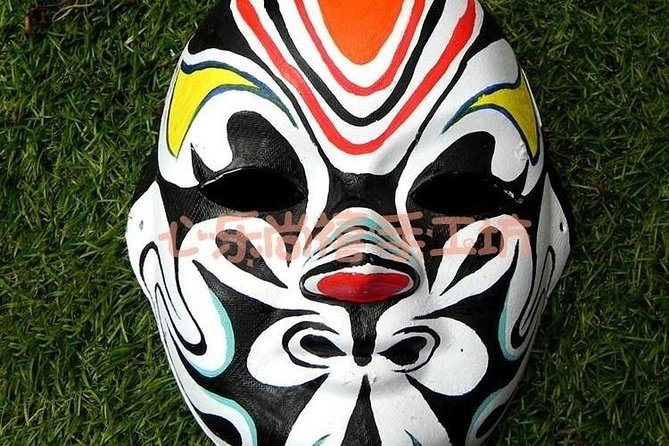Peking Opera
In the bustling streets of ancient Beijing, a cultural gem emerged, captivating audiences for centuries with its vibrant blend of music, dance, and storytelling. Peking Opera, with its elaborate costumes and intricate makeup, transports spectators to a world where tradition meets artistry.
As the curtain rises on this timeless performance, a journey unfolds, brimming with passion, skill, and historical significance. But what secrets lie behind the mesmerizing facade of Peking Opera, drawing in travelers and locals alike?
Key Points

- Peking Opera blends music, dance, and drama with rigorous training for performers.
- Elaborate costumes and makeup symbolize characters’ roles and statuses.
- Stylized movements, gestures, and vocal techniques are iconic in Peking Opera performances.
- Peking Opera holds profound cultural significance, conveying emotions, morals, and history.
Peking Opera Overview
Discover the captivating world of Peking Opera, a traditional Chinese art form that combines music, dance, acrobatics, and drama into an unforgettable theatrical experience.
The evolution of Peking Opera dates back to the late 18th century when it originated in Beijing. This art form merges various regional opera styles and performance techniques, resulting in a unique and vibrant spectacle.
Peking Opera performers undergo rigorous training to master techniques such as singing, acting, dancing, and acrobatics, ensuring a high level of skill and precision in their performances.
The combination of elaborate costumes, intricate makeup, symbolic gestures, and stylized movements distinguishes Peking Opera as a visually stunning and culturally rich art form that continues to captivate audiences worldwide.
History and Origins

Originating in Beijing in the late 18th century, Peking Opera has a rich history that intertwines with the cultural heritage of China. Its origins can be traced back to a combination of various regional operatic styles, including Anhui, Hubei, and Kunqu opera.
Peking Opera, also known as Beijing Opera, evolved significantly over the years, blending these diverse influences into a unique art form that became popular during the Qing Dynasty. The evolution of Peking Opera saw the incorporation of elements like stylized movements, singing, martial arts, and elaborate makeup.
This art form became a cornerstone of Chinese traditional theatre, captivating audiences with its colorful performances and distinctive storytelling techniques.
Traditional Costumes and Makeup

The vibrant colors and intricate designs of traditional Peking Opera costumes and makeup bring characters to life on stage, embodying the essence of Chinese cultural artistry.
-
Costume design: Elaborate embroidery and silk fabrics are commonly used to create visually stunning costumes that reflect the character’s role and status.
-
Makeup techniques: Characters are identified by specific makeup patterns, such as the color red symbolizing loyalty and courage, and the use of exaggerated eyebrows and facial hair.
-
Symbolism: Each color and design element in the costumes and makeup carries symbolic meanings, adding depth to the character portrayal and storytelling.
Iconic Performances and Techniques
With each graceful movement and powerful vocal expression, Peking Opera performers captivate audiences with their iconic performances and masterful techniques. One of the most distinctive aspects of Peking Opera is the use of stylized movements and gestures, known as ‘Jingju.’ Performers train for years to perfect these movements, which convey emotions and actions without the need for words.
The art form also features unique techniques like ‘Bianshen,’ quick changes of character that showcase the performer’s versatility and skill. Another iconic performance element is the use of vocal techniques such as ‘Kouji,’ where performers use different tones and pitches to represent specific characters. These techniques, combined with elaborate costumes and makeup, create a mesmerizing experience for spectators, making Peking Opera a truly unforgettable art form.
Cultural Significance
Peking Opera holds profound cultural significance in Chinese performing arts, showcasing a rich heritage and traditional artistry that has endured for centuries. This art form plays a vital role in the cultural preservation of China, keeping alive ancient stories, music, and costumes for future generations to cherish. Through its elaborate performances and distinctive style, Peking Opera serves as a medium for artistic expression, conveying emotions, morals, and historical narratives with unparalleled grace and skill.
- Peking Opera embodies centuries-old traditions
- It plays a crucial role in cultural preservation
- The art form allows for intricate artistic expression through performance
Modern Adaptations and Influence
Incorporating modern elements and contemporary themes, the opera scene in China continues to evolve and captivate audiences worldwide. Modern interpretations of Peking Opera have breathed new life into this traditional art form, blending classic techniques with innovative storytelling approaches.
Directors and performers are pushing the boundaries by infusing the performances with global influences, attracting a diverse audience beyond China’s borders. These adaptations not only preserve the essence of Peking Opera but also make it relevant to today’s society.
The fusion of traditional aesthetics with modern sensibilities has sparked a renewed interest in this ancient art, ensuring its longevity for future generations. As Peking Opera continues to adapt and resonate with contemporary audiences, its global influence only grows stronger.
Common questions
How Long Does a Typical Peking Opera Performance Last?
A typical performance duration for Peking Opera varies but generally lasts around 3 hours. Known for its cultural significance, Peking Opera showcases a blend of music, dance, acrobatics, and acting. It offers a captivating experience for audiences.
Are There Any Specific Rules or Etiquette That Audience Members Should Follow During a Peking Opera Performance?
When attending a performance, audience behavior plays a crucial role in enhancing the experience. Understanding and respecting traditional customs is key. Be mindful of etiquette like refraining from talking, turning off cell phones, and applauding appropriately.
Are There Opportunities for Audience Members to Interact With the Performers or Learn More About the Art Form After the Show?
Audience engagement opportunities often include post-show discussions and even performer interactions. Backstage access can offer insights into the art form. These interactions enhance the overall experience, allowing for a deeper appreciation of the performance.
What Types of Musical Instruments Are Typically Used in a Peking Opera Performance?
In traditional performances, musical instruments play a crucial role in enhancing the overall experience. The importance of these instruments in creating the ambiance and mood of the show is paramount, complementing the elaborate costumes worn by the performers.
Are There Any Famous Actors or Actresses Known for Their Roles in Peking Opera?
Famous actors have left a lasting impact on the art of theater. Their performances, coupled with intricate traditional costumes, have captivated audiences for generations. The allure of their roles in historical dramas continues to resonate.
Last Words

To sum it up, Peking Opera at Qianmen Jianguo Hotel Liyuan Theater offers a mesmerizing blend of music, dance, and theatrical performances that showcase the rich cultural legacy of China.
With detailed insights into the history, costumes, and techniques of this traditional art form, visitors can expect a truly enchanting experience.
Don’t miss the opportunity to learn about the magic of Peking Opera and witness firsthand its cultural significance and modern adaptations.